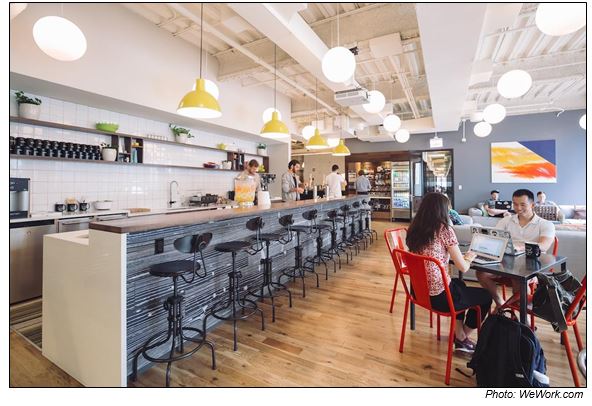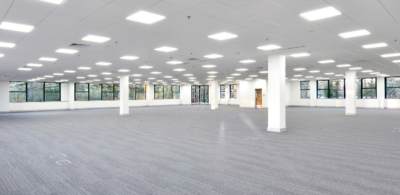WeWork. Regus. Serendipity Labs. LiquidSpace. These are just a few of the names that have staked their claim in the coworking landscape. With coworking and a desire for flexible workplaces on the rise, it’s worth considering the impact these kinds of spaces have had on New York City real estate, as well as what’s driving the increase in desirability.
In 2015, WeWork alone was responsible for 3% of all Manhattan leasing and 9% of all FIREsector deals, leasing nearly 900,000 square feet in total according to Colliers Research. Considering WeWork’s 3-million-square-foot occupancy in Manhattan plus that of Reguswith approximately 1.4 million square feet, when you add in other large players like Corporate Suites, Virgo Business Centers, Jay Suites and a vast host of smaller operators, the footprint of coworking/flexible space easily tops 5 million square feet. While that may seem a large number by some standards, when compared to the combined 504,737,604square feet of office space in Midtown, Midtown South and Downtown, it is actually quitesmall.
While Midtown South has proven to be a well-liked submarket for many coworking and flexible office spaces—notably, WeWork’s headquarters is on West 18th Street—deals for these spaces have been turning up across the city. In Midtown, WeWork has taken 60,000sq. ft. of former USPS space at 450 Lexington Avenue, on top of the 109,631 sq. ft.subleased from Colgate-Palmolive at 300 Park Avenue. Downtown’s absorption rate ticked up with a 235,000-sq.-ft. WeWork lease at 85 Broad Street, the former headquarters of Goldman Sachs; while Regus has also taken hold in former Goldman Sachs space at 77 Water Street. Regus also is extending its reach to a fourth borough, with a 32,000-sq.-ft. office and retail building on the St. George waterfront in Staten Island, announced in February.
The proliferation of providers is noteworthy. According to AlleyVoice, there are more than 50 coworking space operators in NYC, with those in Manhattan including Cowork|rs, AlleyNYC, BluePrint Health, Center4, Centre for Social Innovation, Collab, Con Artist Shared Workspace, FABWORKS, The Farm Soho, 500 Startups, 42West24, Fueled Collective, Impact Hub NYC, Grind, Hive at 55, In Good Company, Joynture, Micro Office Solutions, New Work City, OfficeLinks Hub, The Productive, Projective Space, SoTechie, Spark Labs, Studio Guild, Sunshine Suites, TechSpace, WECREATE, Wix Lounge, WorkHouse NYC, and The Yard. In accordance with supply and demand, the average monthly cost of a dedicated desk at a coworking space in Manhattan is $526 as indicated in a recent Prodigy Network publication.
So what’s driving this uptick in activity? Its growth can be attributed in part to technological advances, shifting work/life priorities, and an evolving economy that has redefined what many think of as traditional office hours and workplaces.
“The ubiquitous ‘coffee shop entrepreneur’ that migrates from their home-based office to the nearest cafe has largely given way to a new group of start-up oriented individuals and businesses that recognize the need for innovative and functional space,” notes Rebecca Green in “Collaborate or Compete: How Do Landlords Respond to the Rise in Coworking?” in the Cornell Real Estate Review.
The exceptional increase in coworking space continues to be driven by a surge of millennials entering the employment marketplace. The Brookings Institution estimates that by the year 2025, a staggering 75 percent of the workforce will be the so-called Net Generation. The expectations these employee cohorts have for their office environment—with flexibility being perhaps the top priority in many instances—have continued to rapidly evolve. The latest in workplace-strategy jargon is the ‘workplace of choice,’ which allows employees to choose how they want to work on a particular day. Choices range from a place to have privacy to a space for collaboration to breakout rooms. It’s part of the social experience; choice of social environment for working goes back to interaction. The idea is to maximize productivity and also to address how people work today.
But it’s not only millennials driving companies’ exploration into coworking and flexible office space. Freelance workers of all ages have taken to these kinds of spaces, realizing in some cases that the “working from home” fantasy held by many doesn’t always hold up its end of the bargain for everyone. To wit, according to a piece in The New York Times, Whitney Tingle, cofounder of organic-meal delivery company Sakara Life, found out that “there was no beginning or end to work,” after she began working out of her home. “I would get distracted by dust bunnies under the desk and end up vacuuming in the middle of the day, or look at myself in the mirror at 7 p.m. and realize I was still in pajamas.” The experience prompted Ms. Tingle and her business partner to apply to Neuehouse, a coworking space with locations in several cities that launched in New York City’s Madison Square neighborhood in 2013.
Further reflecting this societal trend, Fortune 100 companies are increasingly taking desks in temporary facilities, both as a cost cutting measure and as a bridge to attracting and retaining talent by providing environments that cultivate a mix of networking, training, team events, and ideation. WeWork is accommodating tenants with large numbers of employees by offering full floors and modifying space for security, reception, IT, etc.
This paradigm shift has had a considerable effect on the commercial real estate industry, on top of the aforementioned leasing activity. Recognizing the increasing desire by both individuals and organizations to seek out collaborative work environments, Colliers noted some of the key benefits of adapting a coworking mindset in its “How Coworking Can ImproveFlexibility, Reduce Costs and Increase Employee Engagement” report. Positive takeaways include cultural alignment, creation of a more social environment, the ability to provide on-demand solutions and—perhaps the most compelling factor—a not-insignificant amount of cost savings.
With coworking and flexible office space continuing their ascent across the New York City real estate landscape both statistically and anecdotally, it’s clear that these kinds of spaces have become a viable alternative to traditional office settings in the city.
This blog originally appeared on CoreNet Global.
As president of National Office Services for Colliers, Cynthia Foster leads our national office platform across multiple service lines, including capital markets, tenant representation, leasing agency, property management and valuation.

 Colliers Insights Team
Colliers Insights Team

 Aaron Jodka
Aaron Jodka
 Amber Merrigan
Amber Merrigan
 Andrew Steele
Andrew Steele